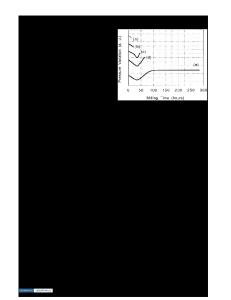Kinetics of In-situ formation of AlN in Al alloy melts by bubbling ammonia gas
- PDF / 1,111,208 Bytes
- 12 Pages / 606.24 x 786 pts Page_size
- 91 Downloads / 374 Views
10/31/03
9:53 AM
Page 793
Kinetics of In-Situ Formation of AlN in Al Alloy Melts by Bubbling Ammonia Gas QINGJUN ZHENG and RAMANA G. REDDY In-situ processing of AlN-Al alloy composites by the gas bubbling method was investigated using ammonia as the gaseous precursor in the temperature range of 1373 to 1523 K. The products were characterized using X-ray diffraction, scanning electron microscopy, and energy-dispersive X-ray microanalysis. It was found that in-situ formation of AlN reinforcing particles was feasible by bubbling ammonia through aluminum and aluminum alloy melts. The AlN particles formed in situ were small in size and enriched in the top part of the product formed in the crucible. In comparison with the purified nitrogen bubbling gas, using ammonia as the nitrogen precursor enhanced the formation of AlN. Hydrogen gas generated from the dissociation of ammonia is an effective oxygen getter in the system, which can offset the deleterious effect of oxygen impurities and enhance the formation of AlN. The rate of formation of AlN was controlled by the diffusion of nitrogen atoms in the liquid boundary layer. A kinetic model was developed to describe the rate of formation of AlN, which was in excellent agreement with the experimental results. The influences of various processing variables on the rate of formation of AlN were also investigated. The rate of formation of AlN changed little with the content of silicon in the matrix melt, increased slightly with increase in temperature and decrease in nozzle size, and increased significantly with the increasing gas flow rate.
I. INTRODUCTION
MATERIALS scientists have understood that the longterm performance and inherent economy of materials are dependent on the economic and effective processing technology to some degree. So far, hundreds of patents have been issued and thousands of technical articles have been published on the topic of processing of discontinuously reinforced aluminum alloy composites (DRACs). Most of them employed solidification (such as vortex, preformed infiltration, and casting) and solid-state (such as powder metallurgy) technologies, in which DRACs are produced by directly incorporating reinforcing particles/fibers/whiskers into matrix alloys.[1–5] DRACs produced by these conventional techniques have been competitive for tribological applications; however, they are still not profitable for structural applications.[6] The small-size reinforcing particles, necessary for the superior mechanical properties, are very expensive. This makes the production cost of DRACs high. It may also be difficult to achieve the optimum mechanical properties of DRACs through these conventional techniques. In the conventional techniques, the reinforcing particles are prepared separately and the particle surface is often contaminated. The surface contamination lowers the accommodating ability of the particles by the matrix alloy, thereby weakening the interfacial bonding. Moreover, the reinforcing particles may be thermodynamically unstable within the matrix
Data Loading...











